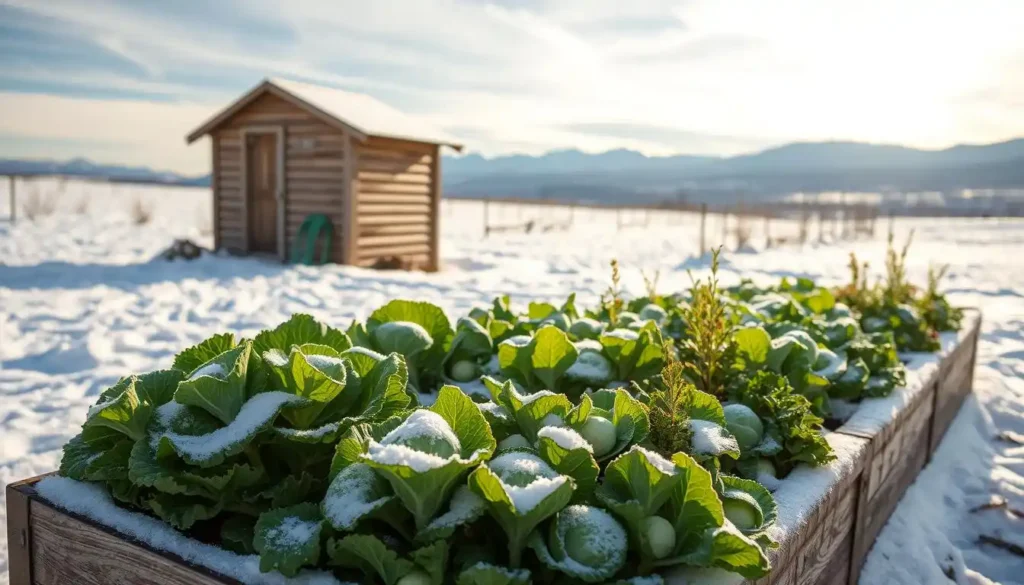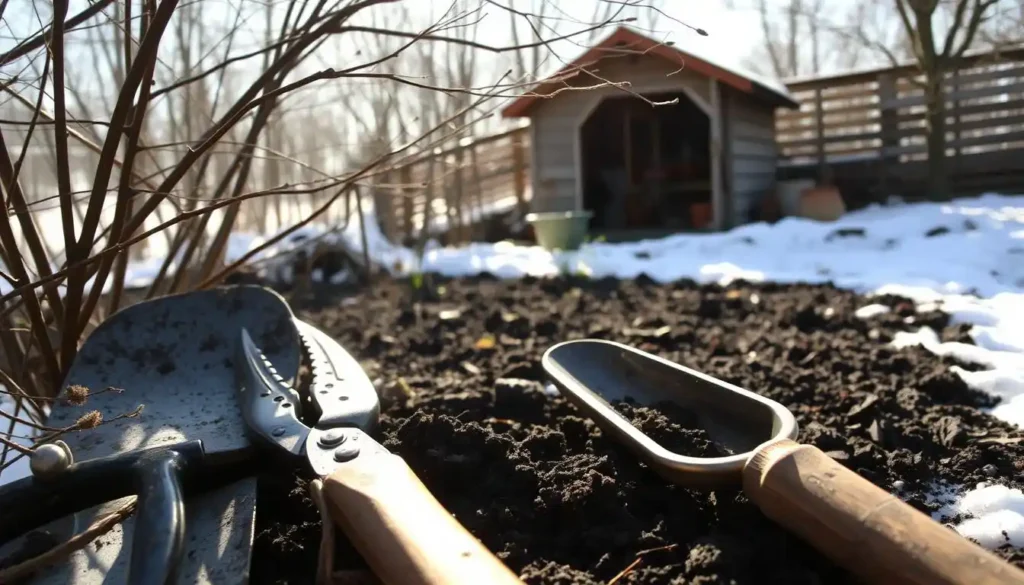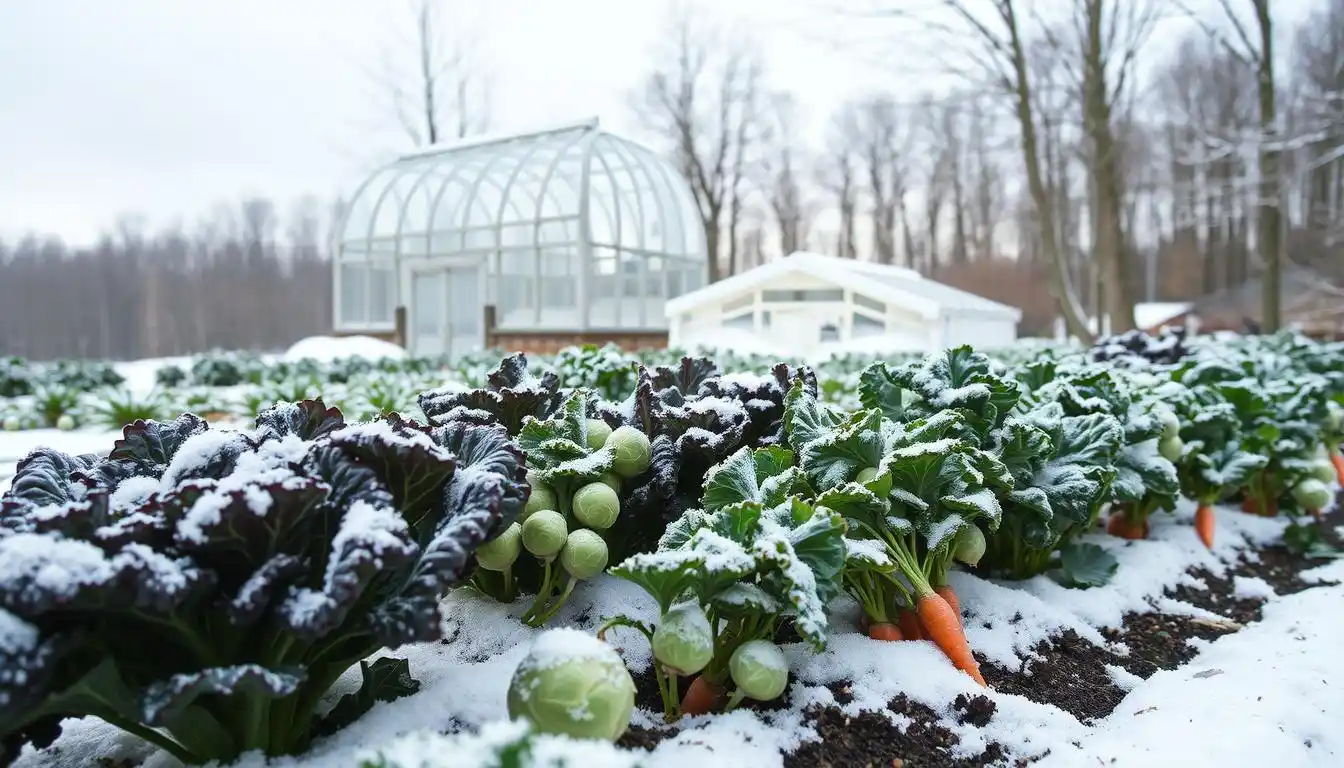Growing your own winter vegetables is rewarding. It gives you fresh produce right in your backyard. Imagine harvesting delicious and nutritious veggies, even in the cold, without going to the store.
You can make a thriving home vegetable garden by picking the right varieties. Just follow a few simple tips. With planning and care, you’ll soon enjoy a harvest of winter veggies. This article will help you start with winter gardening easily.
Table of Contents
Key Takeaways
- Discover the best winter vegetables to grow in your climate.
- Learn how to prepare your garden for winter gardening.
- Understand the benefits of growing your own winter vegetables at home.
- Find out how to care for your winter vegetable garden.
- Get tips on harvesting your winter vegetables.
Why Growing Your Own Winter Vegetables Makes Sense
Growing your own winter vegetables is rewarding. It saves money and boosts your health. Understanding the benefits of growing your own produce is key.
Economic Benefits of Home Winter Gardening
Homegrown winter veggies save you money. You won’t need to buy as much from stores. This cuts down your grocery bills. Here’s how much you can save:
| Produce | Average Store Price | Homegrown Cost | Savings |
|---|---|---|---|
| Kale (per pound) | $3.00 | $0.50 | $2.50 |
| Carrots (per pound) | $1.50 | $0.25 | $1.25 |
| Spinach (per bunch) | $2.50 | $0.50 | $2.00 |
As the table shows, growing your own veggies can save a lot. It’s a smart choice for your family’s budget.
Nutritional Advantages of Fresh Winter Produce
Homegrown winter veggies are full of nutrients. They have more vitamins and minerals than store-bought ones. Fresh produce is crucial for a healthy diet, especially in winter. With your own veggies, your family gets the nutrients they need.

Understanding the Winter Growing Season
Growing vegetables in winter needs a good grasp of the season’s conditions and timelines. Success in your winter garden comes from knowing when to plant and how to protect your crops. It also involves picking varieties that do well in cold.
Cold-Season Planting Calendars for Different US Regions
Planting times change a lot across the US. It’s key to understand these differences for a good winter harvest.
Northern States Planting Guide
In northern states, winter starts around late September or early October. Cool-season crops like broccoli, kale, and spinach need to be planted 8 weeks before the first frost.
Southern States Planting Guide
The southern states have a longer growing season. This means you can plant later. Vegetables like lettuce, carrots, and radishes do well in late fall to early winter.
Midwest and Central States Guide
The Midwest and central states fall in between. Plant cool-season crops in late summer to early fall.
Frost Dates and Growing Zones Explained
Frost dates and your area’s growing zone are crucial. Frost dates tell you when the first and last frosts will hit. Growing zones show which plants will do best. As a gardening expert says, “Knowing your frost dates is like having a roadmap to a successful winter garden.”

Essential Tools and Supplies for Winter Vegetable Gardening
Having the right tools is key for a successful winter garden. The right equipment makes gardening easier and protects your plants from cold.
Basic Equipment Checklist
Start with the basics for winter gardening. You’ll need a strong shovel, a garden fork, and gloves to keep your hands warm and clean. A wheelbarrow or garden cart is also useful for moving things around.
Season Extension Tools and Materials
To grow plants longer, you need special tools and materials. These help make your garden a better place for plants in the cold.
Cold Frames and Cloches
Cold frames and cloches keep plants warm and safe from frost. Cold frames have clear tops that let in sunlight and keep heat in. Cloches are covers for individual plants that do the same thing. Both are great for winter gardening.

Row covers are light, breathable fabrics that protect plants from frost and wind. Frost blankets offer extra protection in very cold weather. These tools are simple to use and very effective.
Heating Options for Extreme Cold
In very cold areas, you might need to use heaters. You can use electric or propane heaters, or even hot water bottles. These can be a big help during really cold times.
Preparing Your Garden for Winter Vegetables
Winter is coming, and your garden needs to be ready for a great harvest. To make sure your winter veggies grow well, follow a few key steps.
Soil Preparation Techniques
Starting with good soil is key for a winter garden. You need to make the soil right for your winter crops and make sure it drains well.
Amending Soil for Winter Crops
To get your soil ready, mix in organic matter like compost or manure. This makes the soil better, adds nutrients, and helps microbes. For clay soils, add perlite or sand to help water drain.
Drainage Solutions for Winter Gardens
Bad drainage can make your soil too wet, which hurts winter crops. Use drainage solutions like French drains or raised beds to keep water away.
| Soil Type | Amendment | Drainage Solution |
|---|---|---|
| Clay | Add perlite or sand | French drains |
| Sandy | Add compost | Raised beds |
| Loamy | Maintain organic matter | Monitor soil moisture |
Creating Optimal Growing Conditions
It’s not just about the soil. Make sure your garden gets enough sunlight and is safe from strong winds. Use row covers or cold frames to keep your crops safe from bad weather.
Winter Vegetables to Grow at Home
Winter doesn’t mean the end of gardening. You can still grow cold-hardy vegetables at home. Many types of vegetables can handle the cold, giving you fresh food all winter.
Cold-Hardy Root Vegetables
Root vegetables like carrots, beets, and parsnips are perfect for winter gardens. They can handle frost and keep growing as it gets colder. These veggies even taste sweeter after a frost because of the starches turning into sugars.
Make sure your soil drains well and is rock-free. This helps the roots grow straight. Plant them in late summer or early fall, so they’re ready before the ground freezes.
Frost-Tolerant Leafy Greens
Leafy greens like kale, spinach, and collard greens are also great for winter. They can handle light frosts and keep producing leaves all winter. These greens are not only tough but also full of nutrients, making them a fantastic winter food choice.
For a steady supply, plant leafy greens in succession, starting in late summer. Use row covers to keep them safe from extreme cold and pests.
Growing Leafy Greens in Winter
You can grow leafy greens in cold weather with the right techniques. These greens are perfect for winter gardens because they’re hardy and grow well in cool temperatures. They also offer lots of nutrients when other veggies are scarce.
Kale and Collards: Cold-Weather Champions
Kale and collards are top picks for winter gardens. They can handle frost and even snow. Choose cold-tolerant varieties like ‘Lacinato’ kale or ‘Georgia’ collards. Plant them in well-draining soil and keep them moist.
Spinach and Swiss Chard Cultivation
Spinach and Swiss chard are great for winter gardens. Spinach loves cooler weather and does well in partial shade. Swiss chard is also cold-hardy and can be picked continuously. Make sure the soil is rich and keep it moist.
Growing Lettuce Varieties in Cold Weather
Lettuce can also be grown in winter. While it might bolt in extreme cold, some varieties are bred for cold tolerance. ‘Rouge d’Hiver’ and ‘Winter Density’ are good options. Plant in partial shade, keep the soil moist, and harvest often to encourage new growth.
| Leafy Green | Cold Hardiness | Growing Tips |
|---|---|---|
| Kale | High | Plant in well-draining soil, provide adequate moisture |
| Spinach | High | Prefers cooler weather, partial shade, consistent moisture |
| Lettuce | Moderate | Plant in partial shade, keep soil moist, harvest regularly |
Root Vegetables for Winter Harvests
Winter is coming, but you can still grow delicious root vegetables in your garden. These veggies can handle cold weather and add flavor to your meals. Carrots, parsnips, turnips, rutabagas, and radishes are great for winter gardens.
Carrots and Parsnips: Sweet Winter Treasures
Carrots and parsnips are favorites for winter gardens. They’re cold-hardy and can stay in the ground until you pick them. A layer of mulch helps protect them from really cold weather.
Both carrots and parsnips get sweeter after a frost. This makes them a tasty winter treat.
Turnips and Rutabagas: Underrated Winter Crops
Turnips and rutabagas are great but often overlooked. They grow well in cold weather. Plus, their greens are good for salads and soups.
Turnips are ready in about 30 days. Rutabagas take around 90 days to grow.
Radishes: Quick-Growing Winter Options
Radishes are fast-growing and perfect for winter. They’re ready in 20 days and can grow in containers or the ground. Radishes add a spicy flavor to salads and can be used as a garnish.
They’re also easy to grow and need little care.
Brassicas: The Winter Garden Workhorses
Brassicas are key players in winter gardens. They are not only nutritious but also bring variety to winter meals.
Brussels Sprouts and Cabbage Cultivation
Brussels sprouts and cabbage are top picks for winter gardens. Plant them in well-draining soil with full sun. Start Brussels sprouts early in spring for a winter harvest.
Growing Broccoli and Cauliflower in Cold Weather
Broccoli and cauliflower love the cooler winter weather. Plant them in rich soil and keep them moist. Use row covers to protect them from extreme cold.
Kohlrabi and Bok Choy: Unusual Winter Vegetables
Kohlrabi and bok choy are unique additions to your winter garden. Kohlrabi grows fast and can be ready in 50 days. Bok choy does well in cooler weather and can grow all winter in milder climates.
Alliums for Winter Growing
When planning your winter vegetable garden, think about adding alliums. These include garlic, onions, and leeks. They’re great for winter gardens because they can handle cold and add lots of flavor to your meals.
Garlic: Plant in Fall, Harvest in Summer
Garlic is a key choice for winter gardens. Plant it in the fall, 6-8 weeks before the ground freezes. Then, harvest it in the summer.
To grow garlic, pick a sunny spot with well-draining soil. Plant each clove 2-3 inches deep and 4-6 inches apart.
- Choose garlic types that fit your area’s climate.
- Make sure the soil is rich in organic matter for healthy growth.
- Water often during the growing season, but don’t overdo it.
Onions and Leeks for Winter Gardens
Onions and leeks are also excellent for winter gardens. They can stay in the garden or be picked before it freezes. Onions keep well for a long time, making them perfect for winter storage. Leeks can be covered with mulch to keep them warm.
To grow onions and leeks, add compost to your soil to help with drainage and nutrients. Plant them in a sunny area and water them often while they grow.
Winter Vegetable Protection Methods
Effective winter vegetable protection methods can greatly improve your harvest. As winter gets closer, it’s key to shield your veggies from harsh weather.
Cold Frames and Row Covers
Cold frames and row covers are simple yet effective for protecting winter veggies. Cold frames work like mini-greenhouses, keeping warmth in and cold out. Row covers, made of lightweight fabric, let sunlight and water through while keeping frost away.
- Use cold frames for sensitive crops like lettuce and spinach.
- Apply row covers to protect a wide range of winter vegetables.
Greenhouses and Hoop Houses
For more extensive protection, think about greenhouses or hoop houses. These structures offer a controlled space, keeping a stable temperature and protecting from harsh winds and frost.
- Greenhouses offer year-round growing capabilities.
- Hoop houses are a cost-effective alternative to traditional greenhouses.
Mulching Techniques for Winter Protection
Mulching is another great way to protect winter veggies. A thick layer of organic mulch around your plants keeps soil moist, stops weeds, and controls soil temperature.
- Use straw or hay for mulching around root vegetables.
- Apply a layer of mulch that’s at least 2-3 inches thick.
Troubleshooting Common Winter Garden Problems
When you care for your winter garden, you might face some common issues. Winter gardening has its own set of challenges. But, with the right knowledge, you can keep your garden healthy and productive.
Dealing with Pests in Cold Weather
Pests can still be a problem in cold weather. Aphids and slugs can survive the winter and harm your plants. Use organic pest control, like introducing beneficial insects or neem oil, to manage these pests.
Managing Diseases in Winter Conditions
Diseases can spread fast in winter gardens, especially when it’s moist. To fight diseases, make sure plants have good air flow. Remove any sick leaves and use fungicides that are safe for cold weather.
Addressing Weather-Related Challenges
Weather challenges, like freeze-thaw cycles and heavy snow, can harm winter gardens. It’s key to protect your plants from these issues.
Protecting Plants from Freeze-Thaw Cycles
To shield plants from freeze-thaw cycles, use row covers or move potted plants to a safe spot. Mulching around plants can also keep the soil warm and protect it from damage.
Managing Snow Load on Structures
Heavy snow can damage garden structures like greenhouses and hoop houses. Clearing snow from these structures regularly can prevent collapse. Use a snow rake or broom to remove snow carefully, avoiding damage to the covering.
Conclusion: Enjoying the Rewards of Winter Vegetable Gardening
Growing your own winter vegetables is rewarding. It lets you have fresh produce in your backyard. By following the tips in this article, you can save money and eat healthier.
Winter gardening offers many benefits. With the right tools and techniques, you can grow tasty and nutritious veggies. Whether you’re experienced or new, harvesting your own veggies is special.
Starting your winter garden is exciting. You’ll see your efforts pay off. With what you’ve learned, you’re ready to enjoy the perks of winter gardening.
FAQ
What are the best winter vegetables to grow at home?
You can grow cold-hardy root vegetables and frost-tolerant leafy greens. Kale, spinach, carrots, and Brussels sprouts are great choices. They do well in winter.
How do I protect my winter vegetables from harsh weather?
Use cold frames, row covers, greenhouses, and hoop houses to protect plants. Mulching also helps keep soil warm and roots safe.
What are the benefits of growing my own winter vegetables?
Growing your own winter vegetables saves money and gives you fresh, nutritious food. You also get to choose varieties without pesticides or chemicals.
How do I prepare my garden for winter vegetables?
Start by adding organic matter to the soil and ensuring good drainage. Adjust the soil pH and remove debris to create the best growing conditions.
Can I grow leafy greens in the winter?
Yes, you can grow leafy greens like kale, collards, spinach, and lettuce in winter. They’re frost-tolerant and do well in cold weather. Just choose the right varieties and protect them.
What are the essential tools for winter vegetable gardening?
You’ll need basic gardening tools like a shovel, trowel, and rake. Also, get season extension tools like cold frames, row covers, and frost blankets to protect your crops.
How do I manage pests and diseases in my winter garden?
Regularly check your garden for pests and diseases. Use organic pest control and remove sick plants. Good garden hygiene and resistant varieties also help.
What are Brassicas, and how do I grow them?
Brassicas include broccoli, cauliflower, and kale. Plant them at the right time for your area. Give them well-draining soil and enough moisture and nutrients.

